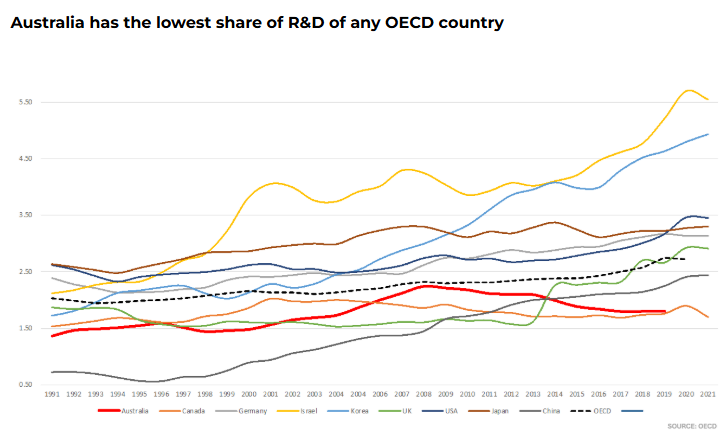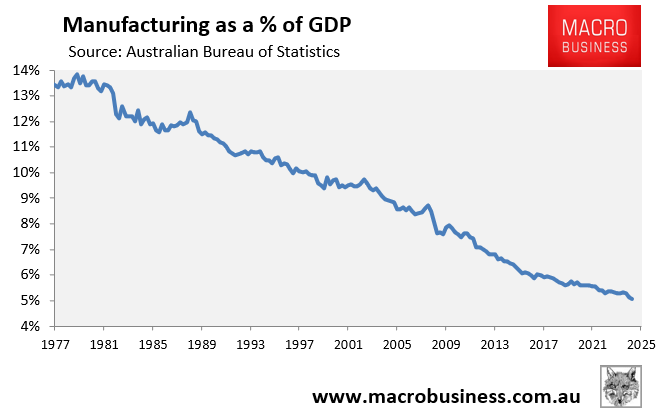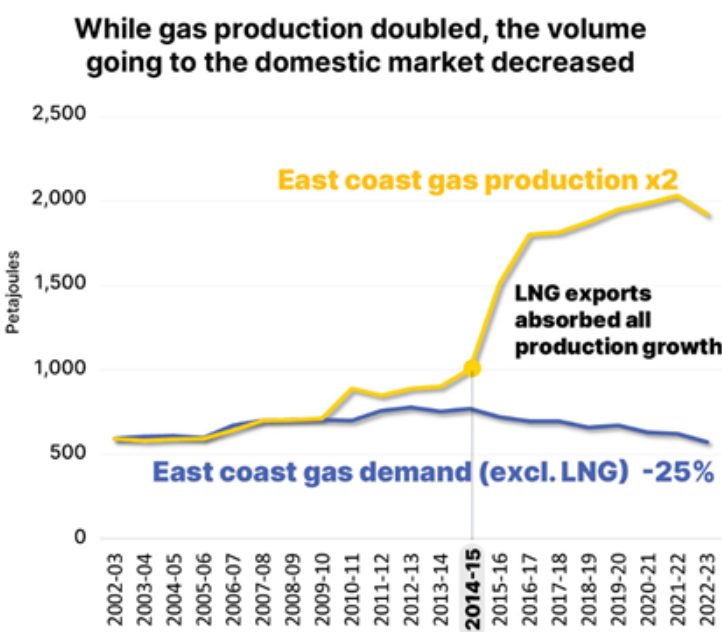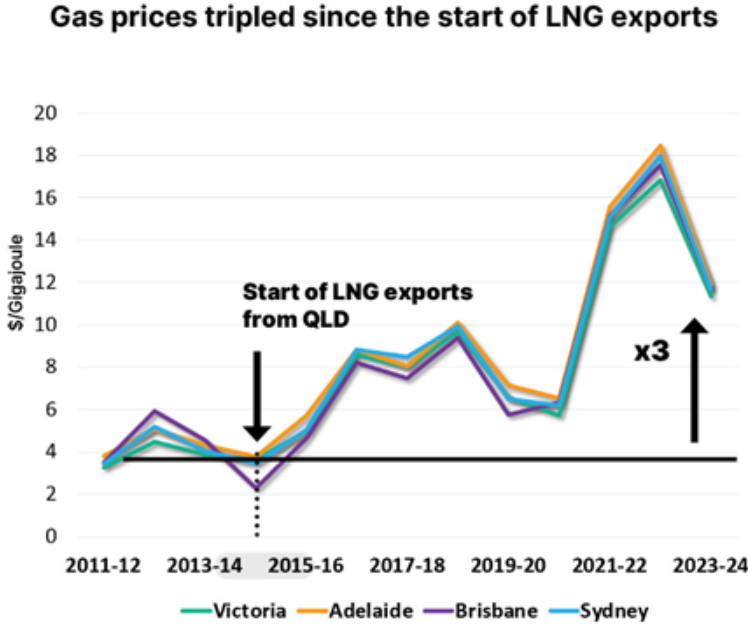According to the OECD, Australia has the smallest manufacturing sector relative to its economy in the developed world.

As a result, Australia is also the least self-sufficient economy in the developed world.
The latest Harvard Atlas of Economic Complexity, which measures the diversity and knowledge intensity of a country’s export mix, ranked Australia 102nd out of 145 countries, behind Bangladesh (100) and Senegal (101).
Australia’s annual spending on R&D has plunged to only 1.68% of GDP, well below the OECD average (3%) and the lowest of developed nations:

The Q1 national accounts, released last week by the Australian Bureau of Statistics (ABS), confirmed that Australia has become a manufacturing wasteland.
As illustrated in the following chart, Australia’s manufacturing share of GDP fell to a record low of 5.1% in Q1 2025, down from 8.9% two decades ago and 15% in the mid-1970s:

Australia’s structural decline in manufacturing has multiple causes.
Tariff reductions in the 1980s and 1990s made Australian manufacturing less competitive against imports, decreasing the sector’s share of GDP.
The 2000s commodity boom appreciated the Australian dollar relative to other currencies, making the local manufacturing sector even less competitive against imported goods and in export markets.
More recently, poor policies have driven up the cost of local energy—gas and electricity— raising input costs and forcing manufacturers to close.
According to ASIC insolvency data, around 1400 manufacturers nationwide have become insolvent since 2022-23.
Among these, Incitec Pivot, a major fertiliser producer, closed its Australian facilities due to rising energy prices.
Qenos, Australia’s last major plastics plant, closed in 2024 due to excessive energy costs, leaving the country entirely reliant on imported polymers from China.
Oceania Glass, Australia’s sole architectural glass company, closed in February 2025 after 169 years of operation, due to high energy costs and Chinese dumping.
Orica, the world’s largest manufacturer of mining explosives, chemicals, and agricultural fertilisers, and BlueScope Steel have threatened to downsize their Australian facilities and relocate to the United States due to rising energy costs.
East Coast Australia’s failure to implement a domestic reservation policy for gas is a key driver of rising energy costs.
The East Coast began exporting gas out of Gladstone in 2015. Since then, gas production volumes have doubled, yet 25% less gas has been supplied to the domestic market.

As a result, an artificial shortage of gas has developed, which has tripled the East Coast gas price to around $12 a gigajoule:

East Coast Australia now pays the highest gas prices out of any exporting jurisdiction in the world. And these high gas prices have also helped drive up electricity prices, since gas is a key marginal price setter in the wholesale market.
The situation is set to worsen with the East Coast scheduled to commence importing gas into NSW, Victoria, and possibly South Australia to overcome artificial domestic shortages.
Once liquefied natural gas (LNG) imports begin, the East Coast gas price will shoot to import-parity prices of around $20 a gigajoule, which will also push up electricity prices.
Hence, implementing a domestic reservation policy on the East Coast is a priority to lower prices and avoid damaging LNG imports.
In March 2025, Manufacturing Australia, which represents large East Coast gas users, called for an East Coast gas reservation scheme modelled on Western Australia. It also warned of price hikes if planned LNG import terminals come online.
“In the long term, [LNG imports] are likely to do more harm than good, and Australia will never regain its energy cost advantage—nor secure the future of manufacturers that need competitively priced gas—if we entrench import parity pricing”, Manufacturing Australia chief executive Ben Eade wrote in The Australian.
“Australia doesn’t need imported gas. We should develop and reserve domestic gas for manufacturers and local customers, rather than pursue solutions that entrench import parity pricing. What’s required is political courage to ensure our abundant natural resources benefit the entire economy, not just the export sector”, Eade said.
The Energy Users Association of Australia, whose members include Brickworks, added that it was unthinkable that one of the world’s biggest LNG exporters was contemplating importing LNG.
“It’s a significant failure of policy, planning and production. It is like importing sand into the Sahara”, EUAA chief executive Andrew Richards said.
The Coalition took an excellent gas policy to the federal election. It promised to implement an East Coast reservation policy via imposing export levies on uncontracted gas.
The Coalition’s levy would have been set at a rate that made it more financially advantageous to sell the gas domestically rather than send it abroad.
The Coalition’s policy aimed to shift the gas equivalent of around 20% of domestic demand from exporters to local users. It promised to deliver East Coast gas for less than $10 per gigajoule, compared to roughly $12 today and $20 if LNG exports commence.
The Coalition also pledged to invest $1 billion in a Critical Gas Infrastructure Fund to expand gas pipeline and storage capacity. Extra pipeline capacity and storage are required to ensure gas flows to Victoria during the peak winter months, when the north-south pipeline is at capacity.
Regrettably, Labor’s Resources Minister Madeline King dismissed the Coalition’s gas reservation policy as a “thought bubble” during the election.
Despite praising Western Australia’s gas reservation policy last week, saying “WA, frankly, showed good vision going forward when they put [the reservation] in place”, Prime Minister Anthony Albanese said that the Coalition’s reservation plan had been “plucked out of a Coco Pops packet”.
The equation is clear. If the Albanese government does not implement a comprehensive East Coast gas reservation policy, then energy prices will surge, which will drive up inflation and send more manufacturers offshore.
Australia will become even more of an industrial wasteland, with a less diversified and complex economy, lower productivity, and lower living standards.
Australia’s manufacturing future is facing a critical moment. Labor must do the right thing, govern on behalf of Australia, and implement a comprehensive East Coast gas reservation policy.

